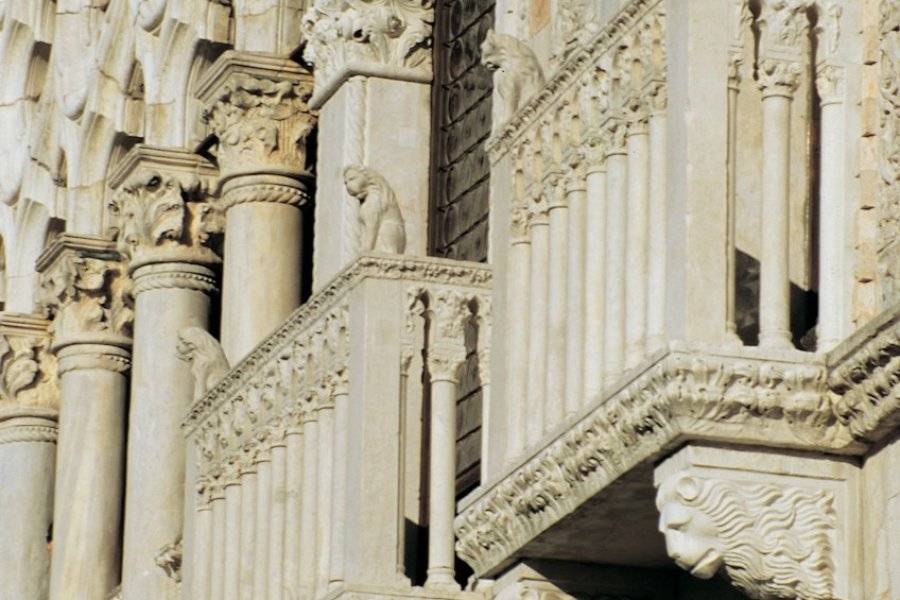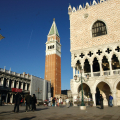Heart of the political and administrative life of the Republic, the Doge's Palace keeps the memory of the history of Venice.
The Ducal Palace, also known as the Doge's Palace, is much more than a sumptuous residence for the rulers of the Venetian Republic. For over a thousand years, it served as the center of government and justice, illustrating the power of the Republic in a unique Venetian-Gothic style that continues to captivate visitors today.
History and architecture
Construction of the Palace dates back to the 9th century, but it was under Doge Sebastiano Ziani, between 1172 and 1178, that it was truly transformed in a Venetian-Byzantine style. Over the centuries, the building underwent a series of enlargements and reconstructions, culminating in its current state in a series of fires and alterations. The first major alterations to the Palace began in the 14th century with the construction of the wing overlooking the quay, followed by a ceremonial Gothic balcony in 1404. In 1424, a new wing was added on the Piazzetta San Marco side, completed by the iconic Porta della Carta (1438-1441) and the Arco Foscari (1462-1471).
After a devastating fire in 1483, the eastern part of the palace was rebuilt in Renaissance style and completed in 1516. Restored for the last time in 1577 following further fires, the Ducal Palace is today a jewel of Venetian architecture and heritage. Visitors enter through the lagoon-side Porta del Frumento (Gate of Closure), so named for its proximity to the Ufficio delle Biade(biade means oats in Italian). Inside, the courtyard reveals two magnificent bronze wells dating from the 16th century, marking the starting point of the visit.
Rooms and staircases
The tour leads first to the doge's apartments on the second floor, then to the institutional halls on the second, continuing with the Armeria and the legendary Piombi prisons, accessible by reservation. Two monumental staircases are located in the eastern wing, the most ornate part of the building. The Scala dei Giganti, designed by Antonio Rizzo, is framed by Sansovino's statues of Neptune and Mars, symbolizing the strength of Venice. This impressive staircase once served as the main entrance to the Palace, and led directly to the Porta della Carta, now used as an exit. It was here that the doges were crowned, surrounded by the Senators' Courtyard, where they would meet. The Scala dei Censori, built in 1525, provides access to the upper floors.
One of the most remarkable architectural achievements is the Scala d'Oro, added in 1559, whose ceilings are adorned with frescoes and stucco gilded with 24-carat fine gold. This staircase is a focal point for visitors, who then proceed to the institutional halls.
The Institutional Rooms
The second floor houses the institutional rooms, whose decoration bears witness to the wealth of the Republic and the talent of the greatest Venetian masters. Among the best-known are the Sala del Consiglio dei Dieci (Council Hall of Ten), used by the magistrates charged with overseeing the city, the Sala della Bussola, and finally, the spectacular Sala del Maggior Consiglio. The latter housed the members of Venice's Grand Council, and is decorated with numerous works of art, including Tintoretto's huge painting Paradise, which stands behind the doge's throne. These majestic rooms illustrate the pomp of the Republic, but also the power and control exercised over the city.
Secret itineraries and private apartments
The Ducal Palace also offers a guided tour of the Secret Itineraries, a special itinerary (by reservation only) that takes visitors into the Republic's former prisons and secret administrative rooms. This itinerary begins in the courtyard and leads to the famous Pozzi (the wells), dark ground-floor cells often flooded (hence their name) where prisoners engraved inscriptions on the walls as a testimony to their stay. The tour continues with the Chancellery, the torture room, and the legendary Piombi, nicknamed for the lead tiles on the roof that trapped the heat. Used for political opponents, the Piombi became famous thanks to Casanova, imprisoned for libertinism and dissolute morals, who escaped in 1755. The tour includes an exploration of the attic's wooden framework, ending in the Sala dei Tre Capi, the room of the three chiefs, decorated with woodwork and paintings illustrating the symbols of Venetian power.
Another itinerary offers visitors a unique opportunity to discover the private apartments of the Doges. These spaces have recently been restored, restoring the Chiesetta and Antichiesetta del Doge to their former glory. In these apartments, visitors can admire the rooms where the safes containing the Republic's treasures were kept. Although no furniture remains, the walls are adorned with frescoes and paintings by great Venetian masters such as Vincenzo Scamozzi and Sebastiano Ricci, as well as superb mosaics. This area also includes the doge's private chapel, adding a spiritual and personal touch to the visit.
Did you know? This review was written by our professional authors.
Members' reviews on PALAZZO DUCALE
The ratings and reviews below reflect the subjective opinions of members and not the opinion of The Little Witty.
Es gibt ein San Marco-Platz-Ticket für Palazzo Ducale und die Museen am Westende des Platzes (Archäologische, Kunst etc.) für 30€.
Rien de sensationnel.
On est loin de la beauté de n'importe quel musée à Florence ou Vienne.
Rien à voir avec le Louvre, L'Hermitage ou la Tate gallery.
Der var renovering flere steder undervejs (room with the 4 doors)hvor audioguide virkede overflødig. Vi havde håbet der ville være mere forhistorie om Venedig, dets oprindelse samt hvorfor Dogen i første omgang blev overhoved, det synes vi der manglede forklaring på. Flot palads, stor våbenudstilling.













Edit: impossible de visiter les autres musées. C'est donc carrément une escroquerie.